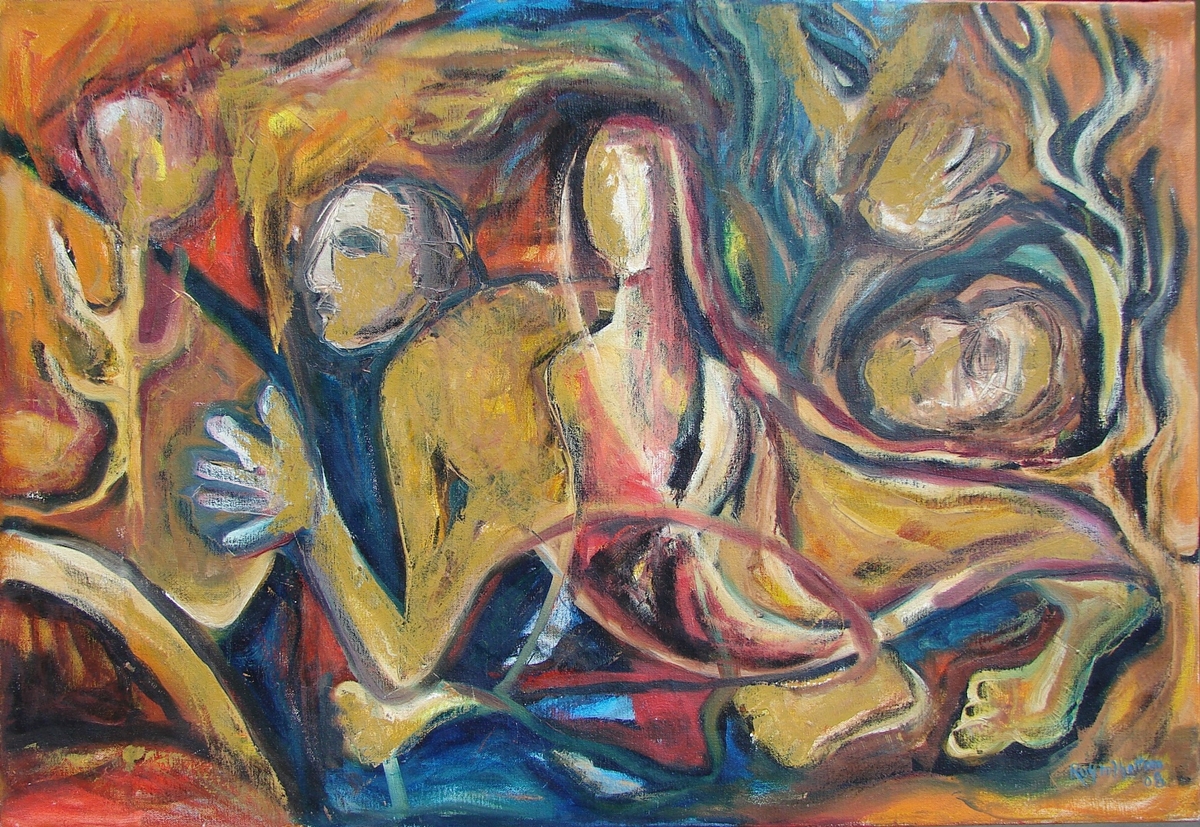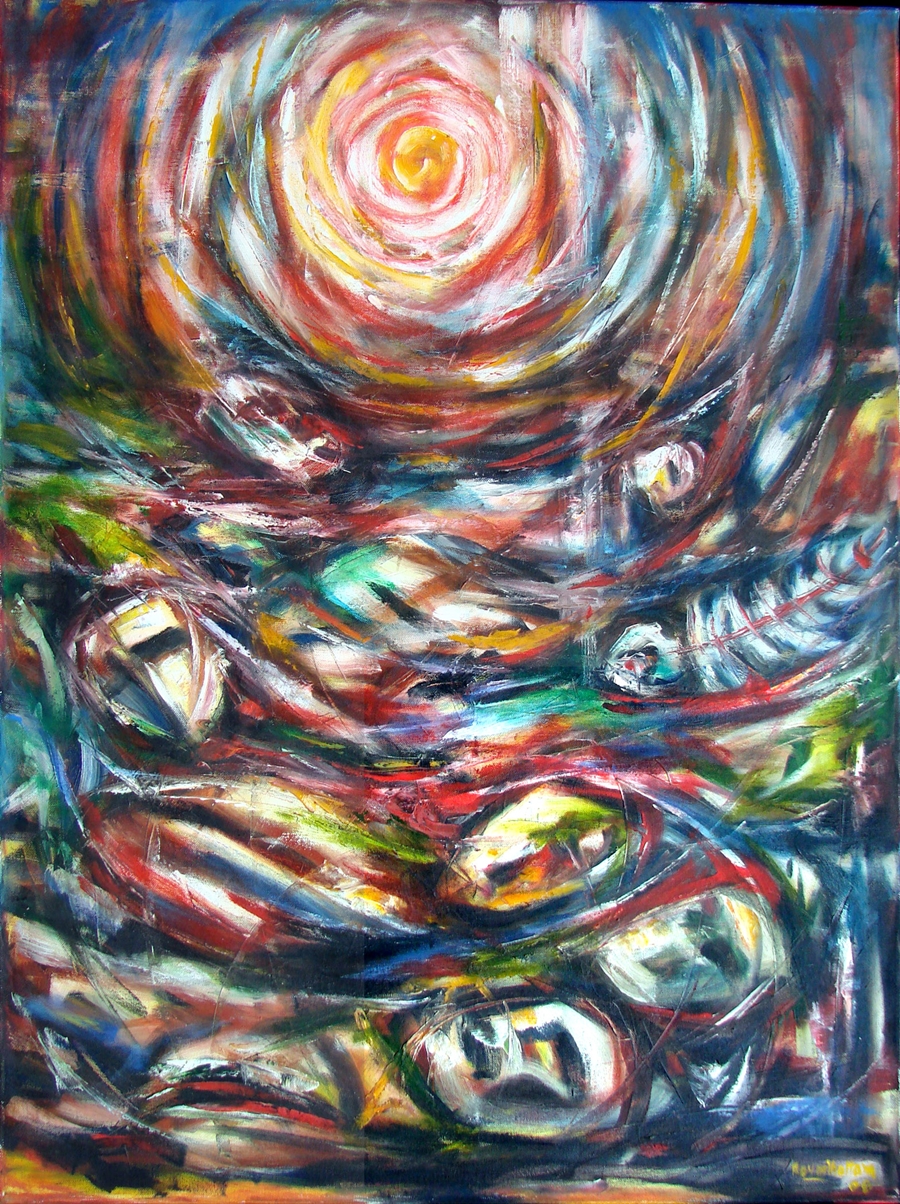ROY M. THOTTAM SJ
There is a hidden mysterious universe in every work of art. It is an experience of pure consciousness, rather than discovering definite answers. So I consider that all my paintings are unfinished in this sense. It continues its journey of ‘becoming’ even if it is a finished work by interacting with the viewers.
Art is essentially spiritual because human beings are essentially spiritual beings. There is an urge in everybody to surpass the external and material into a realm deeper and beyond. I consider this inclination as a primal spiritual urge of Man to attempt to transcend himself and his situations. To a great extent this is achieved through artistic expression. The spiritual in art gives expression to what is deeper and beyond, the invisible and incomprehensible reality. A sense of mystery in the life in which we live is integral to human consciousness. It is a basic primitive consciousness with which we search the ‘ground of our being’.
Paul Tillich said, “everything in human culture has a religious dimension”. The religious dimension he stated is in a broader sense, not as the activities of a group in which the direct relation to a divine being is expressed in ritual and doctrinal symbols. Religion in this sense “can appear in all expressions of man’s cultural activity, both in the created works and in the creating persons”.
The awareness that surface of everything is not real, drives us to break through the layers of deceptive surfaces to the deepest, to the real. “We constantly search for an ultimate reality, something lasting in the flux of transitoriness and finitude” (Tillich, 1989). According to Sri Sankaracharya, a classical Indian philosopher, everything that appears is ‘maya’-illusion. The real lies behind the visible, which can be seen by the ‘inner eye’, the eye of the ‘Self’, through which we can experience the realness of the realities. In art we seek and express what lies behind the visible. This expression does not evade the cultural, historical, mythical and other aspects of human consciousness. So the artistic experience, both creating and viewing, is the experience in its totality. My artistic practice and journey is a dialectical process between the inner and outer realities and it is not distinct from the other aspects of my life. The impulse and struggle is to transcend the outer realities and imageries into a primal and pure experience of reality.
The painting ‘Towards the Unknown’ is a work that stands at the threshold of transition of my artistic practice. As the title indicates, it was a struggle towards the unknown mysterious spheres of art; leaving behind what I was holding onto.

Towards the Unknown
The painting is not an articulation of what I wanted to represent, but it is an expression of my inner world. In the painting, the figure of a man is stretching forward as in a weary journey but with full of energy and hope, looking forward with open hand to reach out to the unknown; leaving behind his ego or false self seen as a dead head at the right side of the painting. The figure of woman at the centre is integrated with the figure of the man, which is his own anima. The yellow and blue background gives the feeling of both desert and oasis; a sense of both weariness and enthusiasm. It gives the sense of life and death.
I consider that every artistic process is a process of liberation. An artist, through his works, liberates himself and the viewers from the illusions of surface and images. The concept of liberation encompasses all aspects of life in relation to the inner and outer world. It is not negating the outer reality, but detaching ourselves from its falsification and getting into the elementary substance where we come in touch with the essence of the reality. Thomas Merton stated that, “In art we find ourselves and lose ourselves at the same time”. Giving up and finding out is the inner working of art. This is a constant process of stripping away. This is what I have experience in my artistic practice. Every work was a process of stripping me away.
There is an urge within me to get in touch with the ground of my being and to give expression to it. This is a journey towards the ultimate freedom of the Self. This is an inner necessity in the artistic process, which is stressed by Kandinsky. “The spiritual life to which art belongs and of which it is one of the mightiest agents, is a complex and definite movements above and beyond…. The determination of the form of a work of art is determined by this irresistible inner force.” Within this view art sprouts from an ‘inner necessity’. Many a times during my art practice, the works emerged mysteriously before me, as if from the unfathomable cosmic and inner sphere.
There is a hidden mysterious universe in every work. It is an experience of pure consciousness, rather than discovering definite answers. So I consider that all my paintings are unfinished in this sense. It continues its journey of ‘becoming’ even if it is a finished work by interacting with the viewers.
Paul Tillich says, “It is not the beauty of art, but its expressiveness that matters”. This expressive power characterizes a painting a work of art. Anything can be a subject matter in this expression, the terrible and tender, the strange and familiar, the absurd and sensible. The expressionist element breaks the surface of reality, pierces into its ground, it reshapes it, re-orders or annihilates the elements in order to have even more powerful expression, in order to express their deeper dimensions forcefully and conspicuously.
The painting ‘Breath of life and Dead Bones’ is based on the subject of human violence. But it is not telling the story of the events but turned to be an expression of the deeper dimension of my artistic inner journey. Spiral movement of light is seen as the breath of life and the dead figures are seen in relation to the spiral movement. (The symbolism of spiral is universal in primitive art. it occurs frequently in Indian art and mythology in the form of the cosmic Serpent, ‘Ananta’ the endless one. According to the philosophy of Yoga, the cosmic spiral force known as ‘Mahaakundali’, ‘the great coiled one’ has also its seat in the human body. Spiral is a symbol pregnant with meaning because it represents the progress of the soul towards ‘Nirvana’, the ultimate freedom and the whole scheme of cosmic evolution). The personal experience of hearing about destructive violence happening in India was the starting point of the painting and then it related to the mythical story of the vision of the valley of dead bones by the prophet Ezekiel described in the Bible (Ezekiel. 37)
An artist’s inner world of feelings and emotions, at times conflicting, and other times, complementary, become more important than any subject. Art transforms crises into creative freedoms. It becomes a life-giving force. It is a process of liberating our real ‘Self’ from social disguises and pretentions, revealing in all its expressive nakedness. Expression with certain madness reveals the primitive depth of the psyche. This whole process is a psycho-spiritual quest, as Emil Nolde states that he “yielded to an irresistible desire to portray a deep spirituality, religion and inwardness; descending into the depth of human divine being”.
As Kuspit affirms for me, painting is, “to be caught in a trap – in a vicious closed circle of rebirth and death – the rebirth of authentic selfhood and the living death of self falsification”. Creativity is the moment of dying to our self and experiencing the rebirth. This is a recurring theme in both Indian and Christian thought. Every work of art was a process of death and a process of coming into
being. ∎
Fr. Roy M. Thottam, SJ is an artist, writer and a founding member of CARP (Company of Artists for Radiance of Peace). Completed his studies in painting at Canterbury Christ Church University, UK. He is the editor of a literary and cultural magazine -Ezhuthu.
